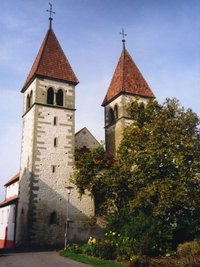Reichenau Island
|
|

Reichenau Island in Lake Constance in southern Germany was declared a World Heritage Site in 2001 because of its monastery, the Abbey of Reichenau. Two further churches were built on the island consecrated to St Georg, and to Sts Peter and Paul, beside the abbey's Münster dedicated to the Virgin and St Mark. The abbey is the best-preserved monastery north of the Alps. The famous artworks of Reichenau include the Ottonian murals of miracles of Christ in St Georg, unique survivals of the 10th century. The abbey's bailiff was housed in a two-storey stone building that was raised by two more storeys of half-timbered construction in the 14th century, one of the oldest half-timbered buildings in south Germany.
Today the island is also famous for its vegetable farms and wineries. The Wollmatinger Ried next to the island is a big nature preserve, a wetland area of reeds which is used by many birds for the stop-over during their annual migration.
The island is connected with the mainland by an artificial causeway.
History
The Alemannic name of the island was Sindleozesauua, but it was also simply known as Ow, Auua, 'island' (Latinized as Augia, later also Augia felix or Augia dives, hence Richenow, Reichenau)
The Benedictine Abbey of Reichenau was founded in 724 by the itinerant St Pirmin]], who is said to have fled Spain ahead of the Moorish invaders, with patronage that included Charles Marteland more locally Count Berthold and the Alemannian Duke Santfrid I (Nebi). Pirmin's conflict with his local patron resulted in his heaving Reichenau in 727, but under his successor Hatto, a kinsman of the Count of Hohenzollern [1] (http://www.reichenau.de/touristikEngl/museum.html), the monastery began to flourish and to gain influence in the Carolingian empire by educating the who staffed Imperial and ducal chanceries. At Reichenau the famous plan for the Abbey of St Gall was drawn up, with its plan for an ideal monastery. Abbot Walahfrid Strabo (842-849) was renowned as a poet and Latin scholar.
The Abbey stood along a main north-south highway between Germany and Italy, where the lake passage eased the arduous route. The Abbey of Reichenau housed a school, and a scriptorium and artists' workshop that has a claim to having been the largest and artistically most influential center for producing lavishly illuminated manuscripts in Europe during the late 10th and early 11th centuries, when this part of Switzerland formed part of the Holy Roman Empire. An example of the scriptorium's production is the Pericopes of Henry II, made for the Emperor, now in Munich. Reichenau has preserved its precious relics, which include the pitcher from the wedding at Cana,
The Abbey reached its apex under Abbot Berno (1008-1048). During this time important scholars such as Hermannus Contractus lived and worked in Reichenau. In the second half of the 11th century, the importance of the Abbey started to wane due to the restrictive reforms of Pope Gregory VII and to rivalry with nearby St. Gall; in 1540 the Bishop of Constance, an old rival of the Reichenau abbots, became lord of Reichenau. and under the control of the succeeding bishops the Abbey dwindled into insignificance. When the abbey lands were secularized and the monks disbanded under Napoleon, part of Reichenau's famed library was preserved in the state library (Landesbibliothek) at Karlsruhe.
See also Reichenau, named for the Abbey which held lands there.
External links
- Reichenau : monastic island (http://www.reichenau.de)
- Reichenau (http://www.schloesser-magazin.de/eng/objekte/re/re_muenstere.php)
- Catholic Encyclopedia: (http://www.newadvent.org/cathen/12723a.htm) Reichenau
